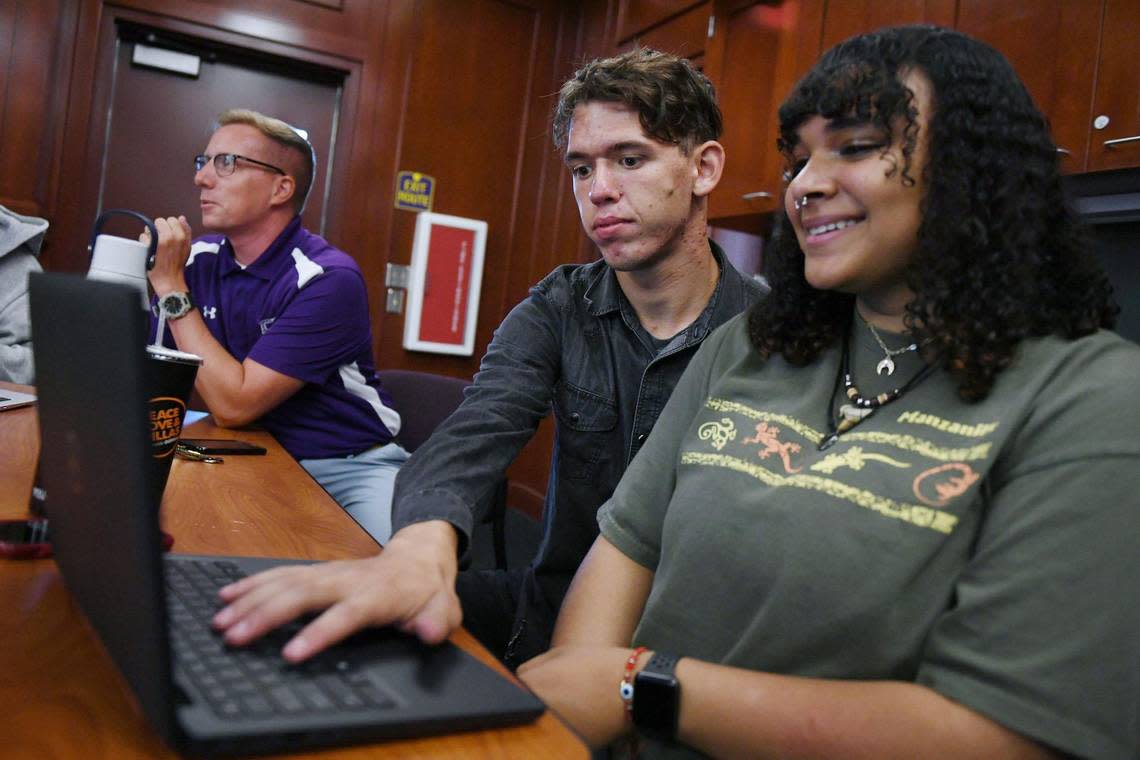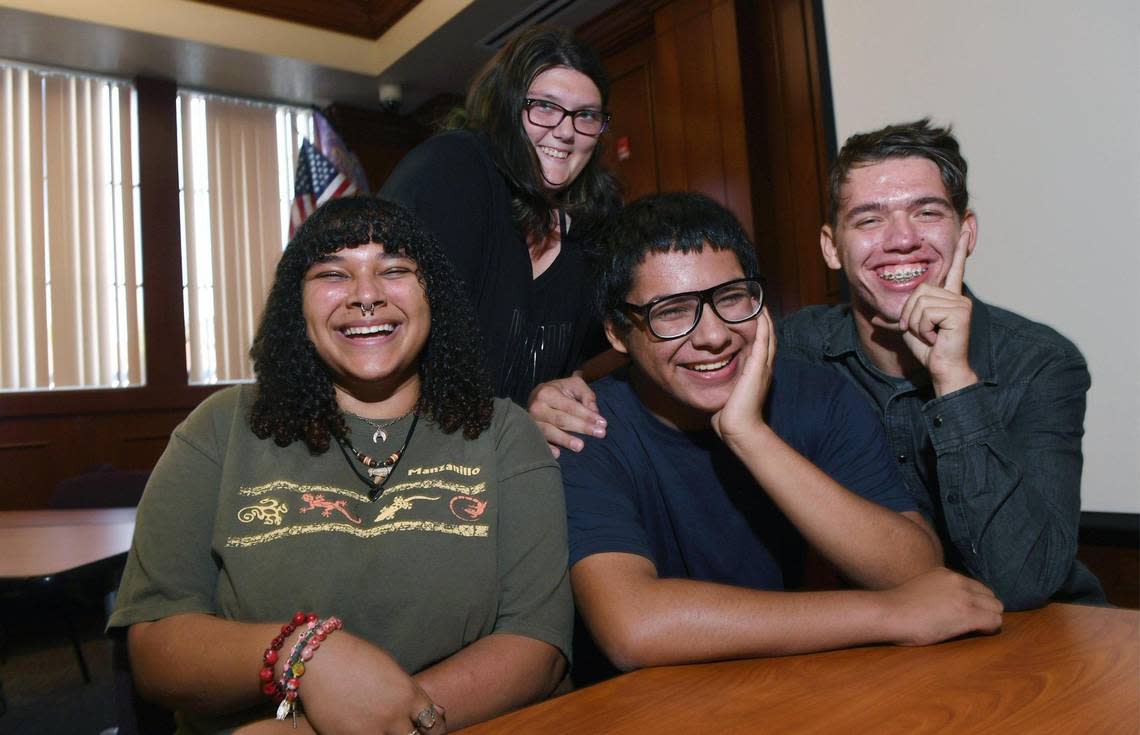Many Fresno-area students already eligible for free money for college from California
Fresno City College freshman Kenissa Austin needed to come up with almost $800 in art supplies for her first semester of classes.
That was going to be an especially tall order for her. As a foster student, Austin has dealt with more challenges than her peers coming up with the money to pay her tuition — namely, not being able to rely on family support to foot the ever-increasing bill for higher education.
“I feel like the financial aid office gave me a hard time,” she told the Education Lab during a recent interview. “I had to do, like, four different things in order to get (aid). So now I’m getting my financial aid late.”
A new program from the state of California aims to help Austin and other students plan ahead for the cost of higher education.
The California Kids Investment and Development Savings Program, nicknamed CalKIDS, will fund college savings accounts of up to $1,500 for eligible low-income, foster and unhoused students and up to $100 in seed money for all babies born on or after July 1, 2022. CalKIDS officially launched Aug. 10.
Eligibility as a low-income student is determined by the Local Control Funding Formula and applies to students enrolled in grades one through twelve during the 2021-2022 school year, according to the CalKIDS site. Beginning this fall, all incoming low-income public school first graders will be automatically enrolled in CalKIDS.
Gov. Gavin Newsom’s office estimates there are currently 3.4 million low-income families with qualifying students across the state. California enrolled just under six million K-12 students as of last school year.
Eligible students have access to CalKIDS funds through age 26 and can use the money for community colleges and universities, as well as trade schools that “participate in federal financial aid programs,” said Julio Martinez, executive director of the state treasury’s ScholarShare Investment Board, in an email to the Education Lab. The board runs CalKIDS.
“Funds may grow interest over time depending on how long they are in the CalKIDS Account before a student requests a distribution,” Martinez added.
Students can’t withdraw the funds themselves or use them for purposes other than paying for higher education, as the state directly disburses CalKIDS funds to a student’s college once they’re enrolled. For students who don’t use the funds for college or trade school, the money remains in the state’s fund to benefit other students.
CalKIDS was just part of a $123.9 billion legislation package that Gov. Gavin Newsom signed into law at Fresno’s Sunset Elementary School in October 2021. The governor’s office cited studies suggesting higher college enrollment and graduation rates among students who have college savings accounts, even with less than $500, as inspiration for the program.
While state-sponsored college savings programs exist in other states like Pennsylvania and Maine, California is now the largest.
CalKIDS in Fresno
Fresno Unified Trustee Andy Levine has championed the program to FUSD employees and students. Although CalKIDS is a state-sponsored program, Levine thinks Fresno Unified can play a vital role in making sure students access the money for college.
For instance, some students will need to know their “Statewide Student Identifier” (or SSID) number to find out their eligibility. That’s different from the local district ID, which Levine said FUSD families are likely more familiar with. They’ll have to contact the school to get a hold of their SSID.
“That’s where the district, I think, (has) really got a role to play,” he said.
Levine said he feels the most urgency to make sure last year’s graduating seniors know about the program, as some of them, like Kenissa Austin, may already be starting college this semester. 83% of last year’s 12th graders, or 3,806 total students, should be eligible, according to FUSD communications officer Russell Goolsby, Jr.
Communication with former students can be a challenge after graduates stop using their school email addresses. Levine said the district plans to use the contact information they gathered from last year’s senior exit surveys to get a hold of those students.
As for current students, leaders with the district and CalKIDS teams said they are trying to determine how many in Fresno Unified would be eligible for CalKIDS funds.
More than 142,000 students are eligible across Fresno County, Martinez said.
Sienna Curtin, a clinical social worker for the district, is doing what she can to help current and former students find out about CalKIDS. She helps run the foster student club at Fresno High, where there’s a higher population of homeless and foster students than any other comprehensive high school in the district.
She, Levine and Fresno High Vice Principal John Kaup already trained one eligible student on how to access his funds. Fresno High senior Christopher Garrett, 17, recently was placed in guardianship after five years in foster care.
He told the Ed Lab his goal after graduation is to study criminology at Fresno City College.
With their help, Garrett was excited to find $1,002 sitting in his CalKIDS account. He’s hoping to help not just his foster siblings check their accounts but other members of Fresno High’s foster club, too.

A domino effect
For the time being, Garrett is balancing extracurriculars like wrestling, his course load, and a job at Taco Bell to save money for college and other living expenses.
That balancing act is familiar to several foster, unhoused and low-income students, Fresno High senior Luis Andrade told the Ed Lab. Andrade described the domino effect that causes students who struggle to secure the financial aid they need to pay for tuition and textbooks.
“If we don’t get (this) financial aid, the money for books is coming out of our own pockets, so we’ll have to work more – working more is gonna take away time from school, which is something that we’re gonna need to get a better job in the future,” he said.
But Curtin said the dominoes could start falling even earlier for foster kids. Lacking stability in housing and income makes it more challenging to plan for the future.
Victor Rivera is another 2022 Fresno High graduate starting at Fresno City College this fall. He and fellow Fresno City freshman Kenissa Austin both talked about how the lack of a built-in support system at home is an obstacle for foster students’ higher education plans.
“It’s kind of hard to have role models,” Rivera said. “Foster parents, they’re really there for you, but it’s a different connection between you and your actual parent … and that’s if you have a good relationship. If you have a bad relationship with your foster parents, then it could make it even more difficult.”
Madison Griffith, another Fresno High senior, is in a uniquely challenging position as an unaccompanied minor, meaning she doesn’t have the support of the foster system. She’s also currently in transitional housing, lacking a permanent place to live.
“For people in my situation, you really don’t have anybody there to support you. You have to figure it out on your own,” she said.
That’s why CalKIDS relieves some of the stress these students face — as is any program that helps take the burden of funding higher education off of their shoulders alone.
“As a first grader, $1,500 is like a million (bucks),” Garrett said. He said he’s hopeful that if the youngest beneficiaries of CalKIDS know that money is waiting for them when they’re still young enough to believe anything is possible, they’ll let themselves dream of higher education.
And while money from the state certainly helps, so do district-level supports.
Austin said if she hadn’t met Curtin at Fresno High, she probably wouldn’t be in college right now. Both Griffith and Rivera added that they’re planning to study psychology because of her.
On a similar note, Levine is hoping FUSD can go above and beyond what CalKIDS offers, ideally in the form of supplemental college funds for some students.
“That’s something that is definitely to be determined, but I think there’s a lot of opportunities there,” he said.

How to find out if you have funds
There are two ways to register your CalKIDS account.
One is by logging in via a unique code in letters to qualifying students and/or families coming directly from the state. Martinez said CalKIDS will start sending these letters out in “the coming months.”
But students could find out sooner by logging into CalKIDS using their SSID. Levine said students should contact their school to request this number.
Students will also need:
Their date of birth
The name of the county where they were enrolled in a public school as of Oct. 6, 2021
More information regarding registration for newborn participants can be found by visiting calkids.org and selecting “Register.”
Students won’t be able to actually access CalKIDS funds until they’re enrolled in a college. Once they’re enrolled, they can request distribution of CalKIDS money directly to their college online.
To do so, students should visit the CalKIDS site and:
Enter the amount of money they would like distributed to their college
Select their college listed on the portal’s drop down menu
Provide their student identification number at their respective college
Certify that they have lived in California for at least one year immediately preceding the use of funds and attends the institution they are requesting funds to be sent to
If a student believes they should be eligible for more than the funds they see available in their accounts, the ScholarShare Investment Board suggests working with their school to make sure accurate data is reported to the state.
The ScholarShare Investment Board’s director Martinez also confirmed that students do not lose access to funds they qualified for due to a change in their status. For example, if a student in foster care is adopted, they will not lose CalKIDS funding.
FUSD students and families can expect communication about the program from the district in the coming months, district communications officer Goolsby, Jr., said.
Education Lab Newsletter
Get stories that matter on education issues critical to the advancement of San Joaquin Valley residents, with a focus on Fresno. Sign up, and join the conversation.
The Education Lab is a local journalism initiative that highlights education issues critical to the advancement of the San Joaquin Valley. It is funded by donors. Learn about The Bee’s Education Lab at its website.
